#Parse Server Cloud Code
Explore tagged Tumblr posts
Text
Supercharging Jira Cloud with Forge Services: A Look Through Sparxsys Solutions
In the world of agile teams and modern project management, Jira Cloud has become a cornerstone tool for collaboration, task tracking, and workflow automation. But with every versatile platform comes the need for customization—and that’s where Jira Forge shines.
With Forge, Atlassian provides a cloud-native development platform that enables developers to create secure, scalable, and reliable apps right within the Jira ecosystem. Among Forge’s most powerful features are Forge Services, which help developers interact with Jira's APIs, manage storage, call external APIs, and more—all while keeping performance and security in check.
In this post, we’ll explore how Jira Forge Services can transform your Jira experience, and we’ll look at how companies like Sparxsys Solutions are leveraging this technology to build real-world apps that solve specific business problems.
What Are Jira Forge Services?
Atlassian Forge Services are a collection of pre-packaged modules that simplify tasks such as:
Storing data (@forge/storage)
Calling remote APIs (@forge/api)
Authenticating with third-party systems (@forge/oauth)
Fetching information from Jira itself (@forge/jira)
These services eliminate the need to set up separate backend infrastructure. Everything runs in Atlassian’s secure cloud, which means no separate servers or databases to maintain.
This serverless model greatly reduces development complexity and security risks, making Forge the ideal platform for small and enterprise teams alike.
Why Use Forge Services?
Whether you’re building an internal Jira app for your organization or creating a marketplace app for global users, Forge Services offer some clear benefits:
Security by Design: Forge apps operate within Atlassian’s security sandbox, so you don’t have to worry about common vulnerabilities like SQL injection or cross-site scripting.
Simplified Development: With built-in services like @forge/api, calling the Jira REST API becomes a breeze. No need to handle authentication headers manually.
Scalability: Since the apps run in the cloud, they scale automatically based on demand.
Low Maintenance: Forge handles hosting, security, and patching, which reduces the overhead for developers.
Real-World Implementation: Sparxsys Solutions
One of the standout players in the Atlassian ecosystem is Sparxsys Solutions, a leading consultancy that specializes in Jira, Confluence, and Atlassian app development. Known for their contributions to the Atlassian Marketplace and strong community presence, Sparxsys has been at the forefront of leveraging Forge Services.
In one of their recent projects, Sparxsys developed a custom Forge app to help a client automate Jira issue creation based on incoming emails from a specific service. Using Forge’s API and storage services, they created an app that:
Listens to email events via a webhook
Parses the email content
Extracts relevant information
Creates a Jira issue automatically with all required custom fields
All of this was done without deploying a single server. The result was a lean, maintainable, and highly scalable solution that was delivered in record time.
A Glimpse at the Code
Here’s a simple example of how @forge/api can be used in a Forge app to fetch Jira issues:
javascript
CopyEdit
import api from '@forge/api'; export async function run() { const response = await api.asApp().requestJira('/rest/api/3/search?jql=assignee=currentUser()'); const data = await response.json(); console.log(data); }
In just a few lines, developers can interact with Jira data securely and efficiently. No tokens, no auth headaches—just clean, direct API access.
What About Forge Limitations?
Forge is still evolving, and there are a few limitations developers should be aware of:
Not all Jira REST API endpoints are currently supported.
Timeouts can affect long-running processes.
Limited ability to run background jobs (though Atlassian is improving this with scheduled triggers).
That said, Forge is gaining features rapidly, and the benefits of serverless architecture often outweigh these limitations for many use cases.
Final Thoughts
Jira Forge Services represent a major leap forward in Atlassian app development. They offer a blend of security, scalability, and simplicity that’s hard to match with traditional app frameworks. By offloading infrastructure concerns, Forge lets developers focus purely on creating value.
Companies like Sparxsys Solutions are already building innovative, real-world solutions on this platform—and that’s just the beginning. Whether you're a seasoned Jira admin or a developer looking to break into the Atlassian ecosystem, now is the perfect time to explore what Forge Services can offer.
Want to get started? Visit the Forge Developer Hub and start building your first app today.
0 notes
Text
Best AI Vocal Removers
…so here’s the scene: you’re hunched over your screen at dawn, coffee gone cold, jonesing for that pristine acapella because you’ve got a remix due in two hours and your deadline doesn’t care if your craft got lost in translation. Welcome to the age of AI vocal removers—a world where one click can snatch Beyoncé’s voice from a beat or bury your own. But is this magic wand an act of liberation or the death knell for nuance? Buckle up.
Once upon a studio, isolating vocals meant ribbon mics, rack-mounted filters, analog tape hiss, and a half-day of painstaking EQ sweeps. Today, tools like Beast To Rap On, LALAL.AI, iZotope RX 11, Moises, and Ultimate Vocal Remover 5 will strip vocals in minutes—often cleaner than your ex’s breakup text. Algorithms trained on terabytes of stems parse spectral signatures as if they were hip-hop playlists. This is efficiency worshipped as progress. But efficiency has a cost.
Think of the free fanatics: Vocal Cleaner Online Free Zero Download is a godsend for bedroom producers living on ramen budgets. Drag‑and‑drop an MP3, hit “process,” and voilà—acapella on tap. You feel powerful. You feel slick. But you also feel a twinge of guilt: is skill being undercut by convenience? Are we building artists or button‑pushers?
Then there’s the pros: iZotope’s Music Rebalance in RX 11 now nails reverb tails and chorus layers so flawlessly you’d swear the singer vanished mid‑phrase. Look at AI Singing Remover—they slapped a slick UI on cloud‑GPU models, paid top dollar for R&D, and pitched “broadcast quality” extraction. But export a 96 kHz .wav and you might spot the chinks: faint glitches under the hi‑hat, or that mechanical hum lurking behind the chorus. It’s progress, sure—but progress always leaves casualties.
Across the digital underground, debates rage. Pull up Joseph Danial’s thread and you’ll see arguments clashing over code and craft: “This is eroding our value,” cries one engineer. “No, it’s democratizing creativity,” fires back another. There’s no referee here—just rapid‑fire opinions and Git diffs. Some mock the robotic artifacts: phase cancellations, spectral warbles, ghostly drum remnants. Others flaunt pristine stems so clean they could pass for studio originals.
Meanwhile, fashion‑tech blogs like “Why AI Audio Stem Splitters Are a Game Changer” preach the gospel of stem splitting beyond music—podcasts, film scoring, virtual reality experiences. Live DJs isolate vocal stems on the fly, blending acapellas into new BPMs without a sweat. High‑end brands sample acapellas to “sonically brand” storefronts. It’s performance art meets marketing strategy. But that “game‑changer” tag sometimes feels like marketing fluff sewn into the seams of couture.
Behind the scenes, R&D budgets balloon. Big tech—cloud servers, SaaS subscriptions, GPU farms—rakes in revenue. Plugin creators scramble to stay relevant. While pros pay hundreds monthly, freebies like NTQMut undercut the market. The result? A snack‑sized economy of microtransactions and fleeting attention spans. That contradiction is the matrix of our so‑called progress.
Head deeper into community archives, like this underground producer’s brag on Freekashmir.mn.co: they turned public‑domain field recordings into modern trap loops by yanking stems from dusty vinyl rips. “I feel like a hacker,” they write, “because I am.” That adrenaline rush—knowing you’ve unshackled samples once trapped—drives culture forward. But ask yourself: when every beat is just a deconstructed, AI‑processed derivative, where’s the soul?
Look beyond DIY: mainline platforms are pivoting too. BBCX1’s AI Singing Remover isn’t just a fun toy—it’s a broadcast‑grade service. Record labels eye licensing arms, pitch remix contests with AI‑cleaned stems, and dream up subscription tiers. The remix economy, once informal and underground, is now a board‑room spreadsheet.
Flip the script: for purists, these removers are sacrilege. The human ear, they argue, is a better filter than any algorithm. Audio engineers still swear by mid/side techniques, phase alignment tricks, and custom spectral gating. They’ll lecture you on the art of “painting with EQ,” coaxing frequencies out of a stereo track by hand. That craft wall is high and narrow—and AI is a wrecking ball.
Yet, that barrier excluded most voices. How many budding producers ever broke into pro studios? Back when you needed Pro Tools rigs and a mentor’s blessing, gatekeepers were plentiful. AI vocal removers tore down that barrier, letting a 16‑year‑old in her bedroom in Perth craft a club anthem that kills on TikTok. Suddenly, cultural voices diversify. Layers once whispered in studio hallways go public. The machine? It’s a megaphone.
Still, beneath the liberation hums a quiet desperation. Who benefits when AI cleans your stems? Professionals see incomes shrink. Small studios watch clients DIY their mixing. Freelance engineers scramble, repackaging “custom vocal isolations” as premium services. And while pros pay hundreds for monthly licenses, freebies undercut the entire ecosystem. That’s not democratization—that’s cannibalization.
Can we talk ethics? Pull acapellas from a chart‑topping track, drop them into a remix, and suddenly you distribute unlicensed vocal stems. AI doesn’t care about copyright; neither do the low‑orbit uploaders hawking “stem packs” on Discord. The legal system is scrambling—DMCA takedowns, lawsuits, takedown notices. Streaming platforms scramble to fingerprint AI‑processed content. Can you trace the lineage of that vocal snippet after three AI pipelines and four pitch‑shift remixes? The machine knows—but nobody else does.
And let’s not forget culture. In hip‑hop, acapella culture goes back to street‑corner cipher tapes—raw battles where spitters slayed on breakbeats. AI removers rip that ritual apart, depersonalizing the cipher into sanitized stems. It’s like framing graffiti: it looks polished, but you lose the grit. In R&B and soul, you risk hollowing out the emotion. Stripped vocals float in a vacuum, divorced from the instrumentation that gave them context, weight, heartbreak.
Yet there’s something wildly beautiful in the chaos. Podcasters mix in musical interludes without studio budgets. Virtual reality soundscapes morph in real time. Film composers isolate dialogue mid‑mix, layering dynamic sound design faster than they can say “boom mic.” Educators repurpose commercial tracks for teaching, extracting vocals to illustrate lyrical techniques. The machine floods fields once reserved for the privileged.
But at what cost? Workers displaced. Skills sidelined. Hybrid workflows abandoned. “I used to teach EQ sculpting,” says a veteran producer. “Now my students just run stems through a free web app.” That sting echoes across classrooms, studios, and living rooms. The AI tidal wave washed away decades‑old pedagogy in weeks.
So where do we go from here? We could recoil and banish AI tools, retreat to analog sanctuaries. Or we could forge new etiquette: mandatory credits for AI stems, ethical sample‑sharing protocols, fair‑use licenses for deconstructed works. Blockchain‑backed stem registries could preserve lineage. Hybrid “human+AI” modes might give artists sliders to dial in imperfection. Or we could lean into the glitch: embrace AI as co‑author, celebrate artifacts as features, and let the glitch be gospel.
Let’s challenge assumptions. Is AI vocal removal a shortcut that kills craft, or the spark that ignites unheard talent? Does open access dilute culture, or does it fertilize new scenes? Are we witnessing the death of the studio, or its metamorphosis into a global node? Every tool is only as honest as the hands that wield it.
But one thing’s certain: this revolution hums in your headphones right now. It doesn’t wait for anyone to catch up. Whether you stand as purist, pragmatist, pirate, or pioneer, the beat goes on—and it’s powered by algorithms. The age of AI vocal removers is no neutral frontier; it’s a battleground for values, culture, and craft.
So ask yourself: when your stems come back cleaner than you ever imagined, what will you do? Will you raise a toast to unfettered creativity, or will you wonder if something essential has slipped through the cracks? Either way, the future isn’t preordained—it’s remixed, reassembled, and reawakened by every click. And in that chaos, maybe we’ll discover something rawer than perfection itself.
1 note
·
View note
Text
Go Programming Training Hyderabad | Golang Training
Start Your Coding Journey: Why Golang Training Is Essential for Beginners:
Golang Training has emerged as a top choice for aspiring developers. Designed by Google, Go (or Golang) is a statically typed, compiled language known for its simplicity, efficiency, and scalability. As organizations adopt Go for cloud services, micros services, and web development, learning this language can be a game-changer for beginners aiming to excel in software development.

Why Golang Is Perfect for Beginners
Golang offers an easy learning curve, making it ideal for those new to programming. Its straightforward syntax reduces the complexity often found in other languages like C++ or Java. Beginners who enroll in Golang Online Training gain hands-on experience with key concepts such as variables, data types, loops, and functions. Moreover, Go's standard library is robust, providing tools for tasks like web server creation and data serialization, which are invaluable for real-world projects.
Another significant benefit of Go is its built-in concurrency model. In today’s multi-core processor era, Go’s lightweight go routines enable developers to run multiple functions simultaneously. Beginners learning through Go Programming Training will appreciate how simple it is to write scalable and concurrent applications without diving into complex threading models.
Key Features of Golang That Make It Beginner-Friendly
1. Simplicity and Readability: Go’s syntax is clean and minimal, making code easy to read and maintain.
2. Performance and Speed: Compiled to machine code, Go ensures faster execution, often rivaling languages like C.
3. Cross-Platform Support: Programs written in Go run on various platforms without significant changes.
4. Comprehensive Standard Library: The language’s built-in tools simplify common tasks like HTTP requests, file I/O, and JSON parsing.
How Golang Training Prepares Beginners for Real-World Success
Golang Course Online equips learners with essential programming skills applicable in real-world projects. Through project-based learning and practical exercises, students gain expertise in
Developing REST APIs, cloud-native services, and more. The structured approach ensures a strong foundation, enabling beginners to transition smoothly into professional software development roles.
Golang Online Training also provides access to experienced instructors who offer personalized guidance. Interactive sessions, code reviews, and collaborative projects simulate real work environments, preparing learners for industry demands. Additionally, course certifications add credibility to resumes, making candidates more attractive to potential employers.
Career Prospects after Golang Training
Go Programming Training IS demand for skilled Go developers is growing across industries like cloud computing, fintech, and blockchain. Companies like Google, Docker, and Uber actively seek developers proficient in Go. Completing a Go Programming Training program can lead to roles such as backend developer, DevOps engineer, or cloud architect, offering competitive salaries and career growth opportunities.
Conclusion
For beginners eager to start a rewarding tech career, enrolling in Golang Training is a smart move. The language’s simplicity, performance, and wide industry adoption make it an invaluable skill. With the right Golang Online Training program, learners can build a solid programming foundation, unlock lucrative career opportunities, and stay ahead in the ever-evolving tech landscape. Start your coding journey today and transform your potential into professional success!
Visualpath is one of the Go Programming Training Hyderabad. We provide real-time Projects with highly skilled and certified trainers with 15+ years of experience. Golang Training is specially designed for IT developers. We are providing demanded in the USA, UK, Canada, India, and Australia. For more information contact us;
Attend Free Demo
Call On: +91 9989971070
Visit Blog: https://visualpathblogs.com/
Visit: https://www.visualpath.in/online-golang-training.html
WhatsApp: https://www.whatsapp.com/catalog/919989971070/
#Golang Online Training#Golang Training#Golang Training In Hyderabad#Go Programming Training#Go Programming Training Hyderabad#Golang Course Online#Golang Training In Ameerpet#Go Programming Training Hyderabad | Golang Training
0 notes
Text
Five9 VoiceStream With Google Cloud CCAI Agent Assist
Google CCAI Agents Assist
Support for Google Cloud CCAI Agent Assist Integration with Five9 VoiceStream. Customers of cloud contact center provider Five9 may view their domain’s audio stream and call events in real time by subscribing to VoiceStream. This article will demonstrate how to use a Five9 gRPC streaming enabled solution to combine VoiceStream Service with Google CCAI Agents.
Using Dialoflow, Five9 cloud contact center may be coupled with Google Cloud’s Agent Assist to manage inquiries from customers and/or human agents in real time. This is a fantastic choice if you’re searching for a platform that can interpret natural language and power Five9 VoiceStream. With this connection, you’ll be able to listen in on your real-time audio interactions with ease and provide your human agents with AI-powered real-time advice.
You may also adjust and fine-tune your virtual agents to the unique needs of each consumer thanks to the connection. By improving the response speeds and tailored experiences of your human agents, you may increase customer happiness and introduce deep customization into your discussions in real time.
CCAI Agent Assist
Introducing an open-source method that combines Five9 VoiceStream with Dialogflow.
The goal at Google is to provide software that is accessible to all users. In light of this dedication, the ensuing solution is readily available and serves as a fundamental building block for integrating Five9’s audio channels for conversations with virtual agents and Google Agent Assist.
What Is The Five9 VoiceStream?
Businesses may record and examine live audio conversations at their contact centers using Five9 VoiceStream, a Real-Time Streaming service. It functions by providing real-time, high-quality audio data to a variety of applications, including analytics, artificial intelligence, and compliance monitoring systems. By offering insights during live contacts, such as detecting sentiment, recognizing client wants, or automating chores, this enables businesses to enhance customer experiences.
VoiceStream is compatible with the larger cloud-based contact center system called Five9 platform. By using real-time data from voice exchanges, it helps firms maintain regulatory compliance, increase agent performance, and improve customer experience.
Five9 VoiceStream: How it Works
It is possible to create middleware that uses Dialogflow to parse audio conversation input and provide real-time recommendations to a human agent speaking with a customer. This solution will manage two levels of communication. Using a VoiceStream subscription, the first one included Five9, and the second one utilized Dialogflow. An upcoming high-level architecture is shown in the figure below.Image Credit To Google Cloud
gRCP Voice Server
The middleware and gRCP Voice Server, as shown in the above diagram, may be developed, tested, and deployed on a fully managed platform like Cloud Run after completing the Five9 self service subscription procedure.
The following are the actors and roles in the solution:
A Five9 subscription is required to build the Five9 VoiceStream role, a gRPC client that connects to the gRPC Voice Server and streams audio from live conversations.
Receiving and processing audio streaming in two channels one for the customer and one for the human agent in accordance with the guidelines on the Five9 voice stream proto file is the responsibility of the gRCP Voice Server.
What middleware does is:
Overseeing the Dialogflow dialogue lifecycle.
Real-time suggestion answers to human agents, comprehending events from a participant (consumer or human agent), and processing conversation audio streams.
Example code for gRCP Server and Middleware.
Google Agent Assist with Five9 VoiceStream
It explained how to combine Google Agent Assist with Five9 VoiceStream in this blog article. Consider these alternative ideas:
Real-Time Call transcription: Record conversations in real time so that agents may refer to them during the conversation or use the transcripts for analysis afterwards.
Real-Time Sentiment Analysis: Sentiment Score is a feature that analyzes talks between a human agent and a customer in real-time to ascertain the emotional intent.
Agent Assist Summarization: This AI-driven Agent Assist function compiles client discussions into an automated summary. The productivity of supervisors and analysts is increased, and contact center agents are able to create better summaries with less work and less time spent reviewing previous talks for returning consumers.
CCAI Insights: Contact center interaction data is provided by CCAI Insights to assist choices and offer business-related answers in order to maximize efficiency.
Read more on govindhtech.com
#Five9VoiceStream#GoogleCloud#CCAIAgentAssist#GoogleCCAI#RealTimeStreaming#CloudRun#gRPC#Middleware#CCAIInsights#GoogleAgentAssist#gRCPVoiceServer#CCAI#technology#technews#news#govindhtech
0 notes
Text
Top E-commerce Websites Scraping API | Extract API from eCommerce Website
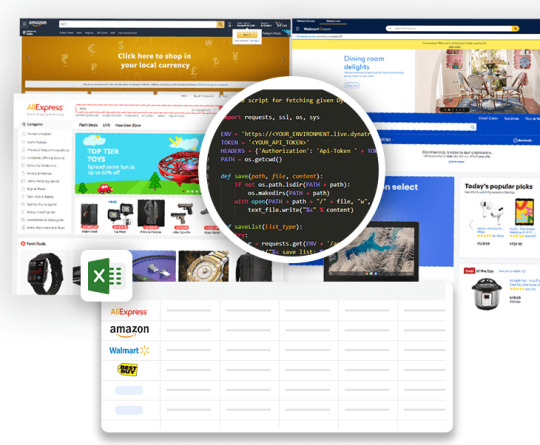
In the world of e-commerce, data is power. Whether you're tracking market trends, monitoring competitor pricing, or keeping an eye on your supply chain, having access to real-time data is essential. This is where scraping APIs come into play. In this blog, we'll dive into the top e-commerce websites scraping APIs and explore how they can help you extract valuable data from e-commerce websites efficiently and effectively.
What is an E-commerce Website Scraping API?
An e-commerce website scraping API is a tool that allows you to extract data from e-commerce websites. This data can include product information, pricing, availability, reviews, and more. Scraping APIs can automate the process of gathering data from multiple websites, making it easier to analyze market trends and gain insights.
Why Use an E-commerce Website Scraping API?
Market Research: Understand the trends and demands in your industry by tracking data from various e-commerce websites.
Competitive Analysis: Monitor your competitors' pricing, product offerings, and customer reviews to stay ahead of the game.
Dynamic Pricing: Keep your pricing strategy agile by adjusting prices based on real-time data from other e-commerce platforms.
Product Discovery: Find new products and suppliers by exploring different e-commerce websites.
Inventory Management: Track product availability and update your inventory in real-time to avoid stockouts.
Top E-commerce Websites Scraping APIs
Scrapy: A popular open-source web crawling framework, Scrapy provides a flexible and efficient way to extract data from e-commerce websites. It supports custom spiders and pipelines for processing data.
ParseHub: ParseHub offers an easy-to-use visual scraping interface, allowing you to create scraping projects without any coding knowledge. It supports advanced features such as pagination and dynamic content handling.
Octoparse: Octoparse is a no-code scraping tool that offers a visual editor to create web scraping tasks. It supports cloud extraction, scheduling, and automated data parsing.
Diffbot: Diffbot provides advanced AI-powered scraping with pre-built APIs for product data extraction. It offers real-time data updates and can handle complex websites.
Bright Data: Bright Data (formerly Luminati Networks) offers a scraping API that supports a wide range of use cases, including e-commerce data extraction. It provides residential and data center proxies for high-quality scraping.
Extracting Data from E-commerce Websites
When using a scraping API, you can extract data from e-commerce websites such as:
Product Information: Extract product names, descriptions, prices, images, and categories.
Pricing: Monitor competitor pricing and dynamic pricing changes.
Availability: Track product availability and stock levels.
Reviews: Gather customer reviews and ratings for products.
Categories: Analyze product categories and subcategories for trends.
Best Practices for Web Scraping
Respect Website Terms of Service: Always adhere to the terms of service of the websites you are scraping to avoid legal issues.
Rate Limiting: Respect the rate limits of websites to avoid overwhelming their servers.
Rotate Proxies: Use proxy servers to avoid getting blocked and to maintain anonymity.
Data Accuracy: Validate the data you collect to ensure its accuracy and reliability.
Conclusion
E-commerce websites scraping APIs are powerful tools for gaining insights into the competitive landscape and staying ahead in the market. By leveraging these APIs, you can automate the process of gathering data and make data-driven decisions for your business. Just remember to follow best practices and respect the websites you're scraping to maintain a positive online presence.
0 notes
Text
Apple Cloud Computing, please

As an Apple developer I feel like there’s a service missing from their offerings. Namely something like AWS or Azure, but for indie devs.
Perhaps that is too small a service or too costly to manage for Apple’s tastes? Remember, Tim Cook loves him a big pile of money.
What I’d like is the ability to host services with Apple. Something like the old Parse prior to Facebook acquiring them. That would allow us small folks to spin up a server without having to manage it.
Now, knowing Apple, this would cost a hojillion dollars to use, which wouldn’t work for an indie like myself, but it would be nice to see them give us an option like that.
Ideal
The ideal service would be a nice restful interface with a dashboard for creation and management of models I could fetch with a simple command per user. I know, I know, it sounds like a slightly enhanced CloudKit at this point which is true, but it would be nice to add the ability to get to these service from any code, be it web or Android or Windows, whatever, and let me save data that is not per user data. Yes, I want a true hosting solution I can spin up with a simple to use web interface and I’d prefer not to have to pay additionally for it.
Now, imagine if small developers who have to pay large sums of money to keep their services running could use a great Apple provider service? I’m looking at you, Castro.
Having a really great option for small to medium indie shops could make the App Store even better.
Hey, a fella can dream, right? 😃
0 notes
Photo

Serverless Battle: AWS Lambda vs Parse Cloud Code
Read more: https://goo.gl/C13HZ5
1 note
·
View note
Text
Using NodeJS and JSON in Mobile App Development
An Introduction to JSON and NodeJS
For individuals who are new to software improvement, older technologies together with PHP and SQL were used to create internet based totally packages based on databases and those had been confronted via a loss of scalability, and regularly wanted a entire redevelopment a good way to increase the platform. The emergence of Javascript and related libraries and frameworks has supposed that as software program packages have emerge as extra data intensive and actual time updates have took place then technologies had been advanced to permit for the increase of the use of these technology.
What is JSON
JSON is a syntax (or technique) for storing and replacing facts; and the information is written as text strings with Javascript Object Notation (JSON). It is without problems read and parsed thru different consumer facet and server facet application interfaces and because of this it's miles useable throughout some of extraordinary programming methodologies. JSON is a relatively efficient way of storing records in a database because of its adaptability.
Why Use NodeJS with JSON?
Front cease builders was limited in growing programs as they have been traditionally simplest capable of deal with writing coding for the patron side of this system. JSON, NodeJS and MongoDB have such ease of use and expand the expertise of JavaScript which has historically been a the front quit development language. With the advent of the usage of cloud based totally computing and ubiquitous net, the legacy days of website hosting large databases in neighborhood servers and having machine administrators deal with all the server languages and renovation along with SQL, Oracle, nodejs PHP and different associated older fashion technologies, front stop builders have taken the usage of their own technology and are actually configuring applications to paintings with net based totally and cloud based totally remote servers. This manner that small scale app development can show up faster and extra easily than writing limitless quantities of code and needing to apprehend server architecture and systems management. Software improvement of the future is responsive, adaptive and dynamic, and in large part mobile and cloud primarily based. JSON and NodeJS constitute big leaps in development on the way to make commercial enterprise and commerce structures far greater efficient.
1 note
·
View note
Text
Complete Flutter and Dart Roadmap 2020
Mohammad Ali Shuvo
Oct 30, 2020·4 min read
DART ROADMAP
Basics
Arrays, Maps
Classes
Play On Dart Compiler
String Interpolation
VARIABLES
var
dynamic
int
String
double
bool
runes
symbols
FINAL AND CONST
differences
const value and const variable
NUMBERS
hex
exponent
parse methods
num methods
math library
STRINGS
methods
interpolation
multi-line string
raw string
LISTS
List (Fixed and Growable)
methods
MAPS
Map (Fixed and Growable)
methods
SETS
Set ((Fixed and Growable)
methods
FUNCTIONS
Function as a variabl
optional and required parameters
fat arrow
named parameters
@required keyword
positional parameters
default parameter values
Function as first-class objects
Anonymous functions
lexical scopes
Lexical closures
OPERATORS
unary postfix expr++ expr — () [] . ?.
unary prefix -expr !expr ~expr ++expr — expr await expr
multiplicative * / % ~/
additive + -
shift << >> >>>
bitwise AND &
bitwise XOR ^
bitwise OR |
relational and type test >= > <= < as is is!
equality == !=
logical AND &&
logical OR ||
if null ??
conditional expr1 ? expr2 : expr3
cascade ..
assignment = *= /= += -= &= ^= etc.
CONTROL FLOW STATEMENTS
if and else
for loops
while and do-while
break and continue
switch and case
assert
EXCEPTIONS (ALL ARE UNCHECKED)
Throw
Catch
on
rethrow
finally
CLASSES
Class members
Constructors
Getting object type
instance variables
getters and setters
Named constructors
Initializer lists
Constant constructors
Redirecting constructors
Factory constructors
instance methods
abstract methods
abstract classes
Inheritance
Overriding
Overriding operators
noSuchMethod()
Extension methods
Enums
Mixins (on keyword in mixins)
Static keyword, static variables and methods
GENERICS
Restricting the parameterized type
Using generic methods
LIBRARIES AND VISIBILITY
import
as
show
hide
deferred
ASYNCHRONY SUPPORT
Futures
await
async
Streams
Stream methods
OTHER TOPICS
Generators
Callable classes
Isolates
Typedefs
Metadata
Custom annotation
Comments, Single-line comments, Multi-line comments, Documentation comments
OTHER KEYWORDS FUNCTIONS
covariant
export
external
part
sync
yield
FLUTTER ROADMAP
Flutter Installation (First App)
Flutter Installation
Basic Structure
Android Directory Structure
iOS Directory Structure
BASICS
MaterialApp
Scaffold
AppBar
Container
Icon
Image
PlaceHolder
RaisedButton
Text
RichText
STATELESS AND STATEFULWIDGETS
Differences
When To Use?
How To Use?
Add Some Functionality
INPUT
Form
Form Field
Text Field
TextEditing Controller
Focus Node
LAYOUTS
Align
Aspect Ratio
Baseline
Center
Constrained Box
Container
Expanded
Fitted Box
FractionallySizedBox
Intrinsic Height
Intrinsic Width
Limited Box
Overflow Box
Padding
Sized Box
SizedOverflowBox
Transform
Column
Flow
Grid View
Indexed Stack
Layout Builder
List Body
List View
Row
Stack
Table
Wrap
Safe Area
MATERIAL COMPONENTS
App bar
Bottom Navigation Bar
Drawer
Material App
Scaffold
SliverAppBar
TabBar
TabBarView
WidgetsApp
NAVIGATOR
pop
Routes
Bottom Navigation
Drawer
Create Multipage App
popUntil
canPop
push
pushNamed
popAndPushNamed
replace
pushAndRemoveUntil
NavigatorObserver
MaterialRouteBuilder
BUTTONS
ButtonBar
DropdownButton
FlatButton
FloatingActionButton
IconButton
OutlineButton
PopupMenuButton
RaisedButton
INPUT AND SELECTIONS
Checkbox
Date & Time Pickers
Radio
Slider
Switch
DIALOGS, ALERTS, AND PANELS
AlertDialog
BottomSheet
ExpansionPanel
SimpleDialog
SnackBar
INFORMATION DISPLAYS
Card
Chip
CircularProgressIndicator
DataTable
LinearProgressIndicator
Tooltip
LAYOUT
Divider
ListTile
Stepper
SCROLLING
CustomScrollView
NestedScrollView
NotificationListener
PageView
RefreshIndicator
ScrollConfiguration
Scrollable
Scrollbar
SingleChildScrollView
Theory …
Flutter -Inside View
Dart
Skia Engine
Performance
Comparison
App Built In Flutter
OTHER USEFUL WIDGETS
MediaQuery
LayoutBuilder
OrientationBuilder
FutureBuilder
StreamBuilder
DraggableScrollableSheet
Learn How to Use Third Party Plugins
CUPERTINO (IOS-STYLE) WIDGETS
CupertinoActionSheet
CupertinoActivityIndicator
CupertinoAlertDialog
CupertinoButton
CupertinoContextMenu
CupertinoDatePicker
CupertinoDialog
CupertinoDialogAction
CupertinoNavigationBar
CupertinoPageScaffold
CupertinoPicker
CupertinoPageTransition
CupertinoScrollbar
CupertinoSegmentedControl
CupertinoSlider
CupertinoSlidingSegmentedControl
CupertinoSwitch
CupertinoTabBar
CupertinoTabScaffold
CupertinoTabView
CupertinoTextField
CupertinoTimerPicker
ANIMATIONS
Ticker
Animation
AnimationController
Tween animation
Physics-based animation
AnimatedWidget
AnimatedBuilder
AnimatedContainer
AnimatedOpacity
AnimatedSize
FadeTransition
Hero
RotationTransition
ScaleTransition
SizeTransition
SlideTransition
NETWORKING
http, dio libraries
json parsing
Local Persistent Storage
SQFLITE
Shared Preferences
Hive
JSON
JSON- PARSING
INTERNATIONALI ZING FLUTTER APPS
Locale
AppLocalization
json files
STATE MANAGEMENT
setState
InheritedWidget
ScopedModel
Provider
Redux
BLOC
OTHER IMPORTANT TOPICS
Widget Tree, Element Tree and Render Tree
App Lifecycle
Dynamic Theming
Flare
Overlay widget
Visibility Widget
Spacer Widget
Universal error
Search Layout
CustomPainter
WidgetsBindingObserver
RouteObserver
SystemChrome
Internet connectivity
Http Interceptor
Google Map
Firebase Auth
Cloud FireStore DB
Real time DB
File/Image Upload
Firebase database
Firestore
Semantic versioning
Finding size and position of widget using RenderObject
Building release APK
Publishing APK on Play Store
RxDart
USEFUL TOOLS
Dev Tools
Observatory
Git and GitHub
Basics
Add ,Commit
Push
Pull
Github,Gitlab And Bitbucket
Learn How to Become UI Pro
Recreate Apps
Animations
Dribble -App Ui
Make Custom Widgets
Native Components
Native Share
Permissions
Local Storage
Bluetooth
WIFI
IR Sensor
API -REST/GRAPH
Consume API
Basics of Web Dev
Server
TESTING AND DEBUGGING
Debugging
Unit Testing
UI (Widget) Testing
Integration Testing
WRITING CUSTOM PLATFORM-SPECIFIC CODE
Platform Channel
Conclusion: There are some courses out there but I believe self-learning is the best. However, you can take help whenever you feel like it. Continue Your Journey By making Apps and also You can clone the existing apps for learning the concept more clearly like Ecommerce , Instagram , Expense Manager , Messenger ,bla bla …….
Most important thing to remember that don’t depend on others too much , when you face any problem just google it and a large flutter community is always with you.
Best of luck for your Flutter journey
Get Ready and Go………..
1 note
·
View note
Quote
The coronavirus outbreak is taking over headlines. Due to the spread of COVID-19, remote work is suddenly an overnight requirement for many. You might be working from home as you are reading this article. With millions working from home for many weeks now, we should seize this opportunity to improve our skills in the domain we are focusing on. Here is my strategy to learn Data Science while working from home with few personal real life projects. "So what should we do?" "Where should we start learning?" Grab your coffee as I explain the process of how you can learn data science sitting at home. This blog is for everyone, from beginners to professionals. Photo by Nick Morrison on Unsplash Prerequisites To start this journey, you will need to cover the prerequisites. No matter which specific field you are in, you will need to learn the following prerequisites for data science. Logic/Algorithms: It’s important to know why we need a particular prerequisite before learning it. Algorithms are basically a set of instructions given to a computer to make it do a specific task. Machine learning is built from various complex algorithms. So you need to understand how algorithms and logic work on a basic level before jumping into complex algorithms needed for machine learning. If you are able to write the logic for any given puzzle with the proper steps, it will be easy for you to understand how these algorithms work and you can write one for yourself. Resources: Some awesome free resources to learn data structures and algorithms in depth. Statistics: Statistics is a collection of tools that you can use to get answers to important questions about data. Machine learning and statistics are two tightly related fields of study. So much so that statisticians refer to machine learning as “applied statistics” or “statistical learning”. Image source : http://me.me/ The following topics should be covered by aspiring data scientists before they start machine learning. Measures of Central Tendency — mean, median, mode, etc Measures of Variability — variance, standard deviation, z-score, etc Probability — probability density function, conditional probability, etc Accuracy — true positive, false positive, sensitivity, etc Hypothesis Testing and Statistical Significance — p-value, null hypothesis, etc Resources: Learn college level statistics in this free 8 hour course. Business: This depends on which domain you want to focus on. It basically involves understanding the particular domain and getting domain expertise before you get into a data science project. This is important as it helps in defining our problem accurately. Resources: Data science for business Brush up your basics This sounds pretty easy but we tend to forget some important basic concepts. It gets difficult to learn more complex concepts and the latest technologies in a specific domain without having a solid foundation in the basics. Here are few concepts you can start revising: Python programming language Python is widely used in data science. Check out this collection of great Python tutorials and these helpful code samples to get started. Image source : memecrunch.com You can also check out this Python3 Cheatsheet that will help you learn new syntax that was released in python3. It'll also help you brush up on basic syntax. And if you want a great free course, check out this Python for Everybody course from Dr. Chuck. General data science skills Want to take a great course on data science concepts? Here's a bunch of data science courses that you can take online, ranked according to thousands of data points. Resources: Data science for beginners - free 6 hour course, What languages should you learn for data science? Data Collection Now it is time for us to explore all the ways you can collect your data. You never know where your data might be hiding. Following are a few ways you can collect your data. Web scraping Web scraping helps you gather structured data from the web, select some of that data, and keep what you selected for whatever use you require. You can start learning BeautifulSoup4 which helps you scrape websites and make your own datasets. Advance Tip: You can automate browsers and get data from interactive web pages such as Firebase using Selenium. It is useful for automating web applications and automating boring web based administration Resources: Web Scraping 101 in Python Cloud servers If your data is stored on cloud servers such as S3, you might need to get familiar with how to get data from there. The following link will help you understand how to implement them using Amazon S3. Resources : Getting started with Amazon S3, How to deploy your site or app to AWS S3 with CloudFront APIs There are millions of websites that provide data through APIs such as Facebook, Twitter, etc. So it is important to learn how they are used and have a good idea on how they are implemented. Resources : What is an API? In English, please, How to build a JSON API with Python, and Getting started with Python API. Data Preprocessing This topic includes everything from data cleaning to feature engineering. It takes a lot of time and effort. So we need to dedicate a lot of time to actually learn it. Image source : https://www.pinterest.com/pin/293648838181843463/ Data cleaning involves different techniques based on the problem and data type. The data needs to be cleaned from irrelevant data, syntax erros, data inconsistencies and missing data. The following guide will get you started with data cleaning. Resources : Ultimate guide to data cleaning Data Preprocessing is an important step in which the data gets transformed, or encoded, so that the machine can easily parse it. It requires time as well as effort to preprocess different types of data which include numerical, textual and image data. Resources : Data Preprocessing: Concepts, All you need to know about text preprocessing for NLP and Machine Learning, Preprocessing for deep learning. Machine Learning Finally we reach our favourite part of data science: Machine Learning. Image source : https://in.pinterest.com/pin/536209899383255279/ My suggestion here would be to first brush up your basic algorithms. Classification — Logistic Regression, RandomForest, SVM, Naive Bayes, Decision Trees Resources : Types of classification algorithms in Machine Learning, Classification Algorithms in Machine Learning Regression — Linear Regression, RandomForest, Polynomial Regression Resources : Introduction to Linear Regression , Use Linear Regression models to predict quadratic, root, and polynomial functions, 7 Regression Techniques you should know, Selecting the best Machine Learning algorithm for your regression problem, Clustering — K-Means Clustering, DBSCAN, Agglomerative Hierarchical Clustering Resources : Clustering algorithms Gradient Boosting — XGBoost, Catboost, AdaBoost Resources : Gradient boosting from scratch, Understanding Gradient Boosting Machines I urge you all to understand the math behind these algorithms so you have a clear idea of how it actually works. You can refer to this blog where I have implemented XGBoost from scratch — Implementing XGBoost from scratch Now you can move on to Neural Networks and start your Deep Learning journey. Resources: Deep Learning for Developers, Introduction to Deep Learning with Tensorflow, How to develop neural networks with Tensorflow, Learn how deep neural networks work You can then further dive deep into how LSTM, Siamese Networks, CapsNet and BERT works. Hackathons: Image Source : https://me.me/ Now we need to implement these algorithms on a competitive level. You can start looking for online Data Science Hackathons. Here is the list of websites where I try to compete with other data scientists. Analytics Vidhya — https://datahack.analyticsvidhya.com/contest/all/ Kaggle — https://www.kaggle.com/competitions Hackerearth — https://www.hackerearth.com/challenges/ MachineHack — https://www.machinehack.com/ TechGig — https://www.techgig.com/challenge Dare2compete — https://dare2compete.com/e/competitions/latest Crowdanalytix — https://www.crowdanalytix.com/community To have a look at a winning solution, here is a link to my winning solution to one online Hackathon on Analytics Vidhya — https://github.com/Sid11/AnalyticsVidhya_DataSupremacy Projects: We see people working on dummy data and still don’t get the taste of how actual data looks like. In my opinion, working on real life data gives you a very clear idea how data in real life looks like. The amount of time and effort required in cleaning real life data takes about 70% of your project’s time. Here are the best free open data sources anyone can use Open Government Data — https://data.gov.in/ Data about real contributed by thousands of users and organizations across the world — https://data.world/datasets/real 19 public datasets for Data Science Project — https://www.springboard.com/blog/free-public-data-sets-data-science-project/ Business Intelligence After you get the results from your project, it is now time to make business decisions from those results. Business Intelligence is a suite of software and services that helps transform data into actionable intelligence and knowledge. This can be done by creating a dashboard from the output of our model. Tableau is a powerful and the fastest growing data visualization tool used in the Business Intelligence Industry. It helps in simplifying raw data into the very easily understandable format. Data analysis is very fast with Tableau and the visualizations created are in the form of dashboards and worksheets.
http://damianfallon.blogspot.com/2020/03/how-to-improve-your-data-science-skills_31.html
1 note
·
View note
Text
Top 10 PHP Frameworks For Web development That Ruled in 2019
Other than that Suhanasoftech Pvt. Ltd. is a professional It firm that deals with authentic PHP projects
What is PHP?
PHP is one of the numerous server-side dialects you can figure out how to construct sites. It joins different dialects, for example, Java, ASP.NET, Ruby, and R. 80% of the best 10 sites are fueled by PHP, including Facebook and Wikipedia. PHP has reliably exhibited its capacity to scale the biggest sites while simultaneously having a simpler expectation to learn and adapt than different dialects. This article clarifies why you ought to learn PHP and what it can accomplish for your profession. For this purpose you need to learn PHP course from the best PHP training institute in Kolkata.
Why Should You Learn PHP?
A slick component of PHP is that it's truly adaptable and flexible. PHP is nearly equivalent to on the off chance that it was an item arranged language, making it an exceptionally helpful language to work with. It likewise has a very ground-breaking meta-language for designers.
PHP is ordinarily used to run Web locales, however, you can run PHP on your Windows, macOS, and Linux workstations. The least demanding approach to run PHP is to introduce Docker and afterward run a compartment with PHP included. The compartment alluded to in the connection has PHP, MySQL, and NGINX running in a solitary holder. You can be ready for action in a couple of hours. Thus we need to learn PHP from the best PHP training center in Kolkata.
Applications of PHP:-
PHP is mainly responsible for building and developing Web Application, thus it is considered to be the professional PHP course in Kolkata but other than this PHP also serves in different cases such as:
Building and Developing Mobile Apps.
PHP can be used for Artificial Intelligence and Machine Learning purpose.
Cloud Programming with LAMBDA can also be implemented by PHP.
About PHP Framework:-
PHP, which represents Hypertext Preprocessor, is a server-side scripting language that is utilized for building dynamic sites and applications. It is the most well known server-side language, which gives the capacity to fabricate secure, complex, and elite web applications rapidly. It is the language of decision for some web designers, with regards to making dynamic web arrangements. You can procure PHP engineer to make extraordinary web applications for your business.
In addition, the estimation of PHP is considerably higher with its systems that disentangle and speed up PHP coding. PHP structures come in various shapes and measures and cook various engineers with a fluctuated level of understanding, facilitating abilities, application needs and improvement time allotments.
Frequently designers need to compose similar lines of code over and over likewise they need to construct a wide range of arrangements from easy to complex. PHP structures assist engineers with expelling the dull work and manufacture PHP web improvement arrangements rapidly. In addition, they likewise lessen the intricacy of coding to a critical degree. In this manner, engineers utilize different structures to create PHP arrangements.
There are many PHP structures to look over and each accompanies astounding highlights to make quality PHP code. Right now, we will take a perspective on the main 10 PHP structures that are exceptionally well known in 2019 and broadly used for making web advancement arrangements. Which is why you need to take lessons on Advanced PHP course in Kolkata or where ever you stay
Top 10 PHP Frameworks:-
Symfony:- Symfony has been here for quite a while and it's one of the most well-known PHP structures utilized for growing top of the line web applications. It gives engineers a few reusable PHP code and segments. It is an ideal decision with regard to growing enormous scale venture arrangements.
Symfony's advancement group gives instructional classes in various dialects and they additionally update their online journals routinely so as to keep the enormous network drew in with them. It is generally utilized by designers because of its propelled highlights and simple to utilize condition.
The reusable PHP libraries are utilized by Symfony parts which disentangle many web improvement errands like article arrangement, structure creation, steering verification, templating and that's just the beginning. In addition, this structure has a lofty expectation to absorb information because of the countless highlights it offers. By the by, the developing network and numerous informal care groups help to learn and to get acquainted with Symfony effectively.
Cake PHP:- CakePHP is a perfect PHP system for fledglings, and it is useful for creating business web arrangements quickly. It offers framework usefulness and code age, which assists speeding with increasing the improvement procedure and gives loads of bundles to deal with regular usefulness.
CakePHP is allowed to utilize whether it's for business or individual use. It has been utilized by brands to construct different web arrangements. It has an exceptional MVC shows that give direction to the advancement procedure.
It is likewise extremely simple to arrange this structure as it wipes out the prerequisite for confounded YAML or XML design records. You can manufacture venture rapidly with this structure and it offers security includes that forestall dangers like CSRF, XSS, SQL infuses, and furthermore give structure approval apparatuses.
There are a ton of dynamic help reports to learn and get acquainted with CakePHP. In addition, there are many assistance entryways to begin for tenderfoots.
Zend Framework:- Zend Framework is a serious famous PHP structure as it is known as a go-to proficient system utilized for building elite applications. It is broadly utilized for building proficient undertaking level web applications. This system is planned with extensibility, execution, and security as a top priority.
There is a not insignificant rundown of highlights that Zend Framework gives to its clients like segments for structures, nourishes, administrations, verification, and so forth, front-end upheld simplified editorial manager, cryptographic coding device, PHP unit testing apparatus and that's only the tip of the iceberg. Zend is likewise connected with monster tech organizations like Google IBM, Microsoft, and so on.
Codeigniter:- It is a lightweight and a strong PHP system, which enables the growing top of the line to web applications. CodeIgniter accompanies a few propelled includes and empowers the designers to manufacture web arrangements rapidly and easily. It involves a library that offers a straightforward interface that requires a sensible structure for getting to its highlights. It is favored by numerous designers as it offers to assemble inventive arrangements with the negligible utilization of coding.
Making undeniable web applications with CodeIgniter is a breeze as it has a little expectation to absorb information and a few valuable libraries. There is an enormous and supportive network out there for CodeIgniter. Additionally, there is likewise a ton of documentation to learn and get acquainted with this structure.
CodeIgniter is sponsored by The British Columbia Institute of Technology, which guarantees its consistent development and advancement. It offers broad highlights, which incorporate structure approval, unit testing, email sessions, and the sky is the limit from there. In the event that, you don't discover a library for a specific assignment, you can likewise construct your own and offer it with the network as well.
Yii 2:- It is the most established PHP structure, which isn't upheld an organization rather an enormous number of worldwide designers offer help for Yii 2. It is a contender for Symfony 2 and has a simpler expectation to learn and adapt. It has a few remarkable highlights and it is favored when engineers need to make arrangements that offer quick outcomes.
Yii2 has a decent structure, which empowers it to work with AJAX and supports ground-breaking reserving. It empowers the designers to change database information into articles and aides dodging the multifaceted nature of composing SQL questions more than once. Yii 2 permits making proficient, effectively viable, and extensible web applications.
Phalcon:- It is altogether different from other PHP systems since it has an alternate coding style which depends on C/C++. Be that as it may, it gives progressed and extraordinary highlights to grow top of the line web applications. There is a lot of uncommon highlights offered by Phalcon which incorporate general autoloader, reserving, resource the executives and the sky is the limit from there.
Phalcon is simple and can be seen rapidly. With the point by point documentation accessible for Phalcon causes designers to assemble the PHP stage all the more effectively and rapidly. In contrast with different structures, it utilizes a negligible measure of assets, which brings about quick HTTP demands, so it's blasting quickly.
It offers incredible parts like MVC, ORM, auto-stacking and reserving and it gives information stockpiling devices because of its own SQL language, which is PHQL. Aside
from this, it likewise offers Object Document Mapping for MongoDB. There are numerous highlights like structure manufacturers, universal language support, Template motors, and give simplicity of building web applications. It is valuable for building undeniable web applications or high-performing REST APIs.
FuelPHP:- It is a cutting edge, extensible, advanced and exceptionally secluded PHP system which bolsters MVC (Model-View-Controller). FuelPHP is based on the HMVC (Hierarchical Model-View-Controller) design which is the improved variant of MVC. It has many energizing highlights, for example, incredible and lightweight help for ORM, security upgrades, format parsing, validation system, and a few different bundles to expand engineers' capacities.
With its broad security highlights which address a significant number of security issues of the applications, designers can make exceptionally verify answers for their customers. There are a few vigorous highlights like yield encoding, URL sifting, and more that empower to construct secure web applications. Because of its own confirmation structure, FuelPHP is generally used for making start to finish web arrangements.
Laravel:- Laravel is the lord of all PHP systems. In the event that you need to create lovely and remarkable web applications, you can depend on Laravel. It is a go-to PHP system that is broadly utilized by web craftsmen to create the highest arrangements. The explanation behind why Laravel is so extraordinary lies in its wide prominence and usability as it doesn't for all intents and purposes have an expectation to learn and adapt.
This system is used by engineers to finish various kinds of genuine tasks. From the start, this system may appear to be a straightforward device, yet it's actually a total answer for a wide range of solid activities.
It accompanies a lot of inherent highlights which offer fast improvement and rearrange coding. Other than this, it additionally accompanies its own templating motor Blade, progressed RESTful directing framework, nearby improvement condition, Homestead and huge amounts of different highlights. It bolsters MVC engineering and offers a bundling framework, ORM, unit testing and that's only the tip of the iceberg.
With Queue the executives, it handles tasks out of sight and logs action when assignments are running in the text style end. The implicit Composer into Laravel makes including bundles a breeze. It handles Redis or MongoDB well. It is well known and there is a great deal of documentation and learning assets that are effectively found to get acclimated with this system.
Slim Framework:- With its improved highlights, Slim Framework empowers you to fabricate propelled web zing highlights like encryption, URL directing, treat, sessions and that's only the tip of applications. This system is very well known among engineers for building APIs as it offers simple strides to make wanted APIs. As a miniaturized scale PHP system, it's extremely lightweight and utilized for growing little web arrangements. This structure is generally used for making RESTful APIs and different web administrations. It offers a great deal of damage iceberg.
PHPixie:- It's a full-stack PHP structure which is utilized for making superior web applications. It bolsters HMVC and worked with singular segments. A people group is there which takes care of the normal updates of the system. It is anything but difficult to begin with, it is modularized and gathers quick
As a best and professional PHP training in Kolkata, Acesoftech Academy has earned its position amongst all other PHP development institutes in Kolkata.
1 note
·
View note
Text
MEAN Stack: What and Why
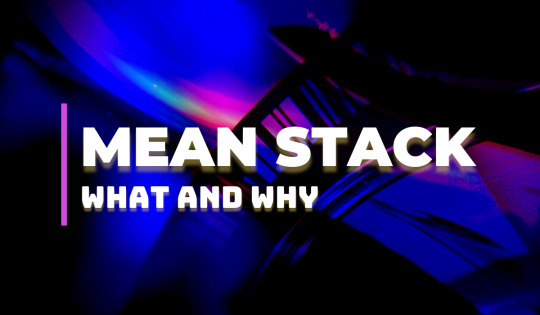
What is MEAN?
MEAN represents MongoDB, Express.js, AngularJS, and Node.js. It is an end-to-end JavaScript used in cloud-ready web applications. It is built to ease the development of web applications and handle JSON.
MEAN stacks have flexibility, and scalability, and their ability to handle concurrent users makes them ideal for cloud hosting. It has its web server that can be deployed quickly and the database can be scaled to accommodate temporary usage spikes.
The MEAN stack comprises four technologies-
MongoDB -An open-source NoSQL database
Express - Forms the backend of MEAN and handles all interactions between the front end and database.
AngularJS - Used to develop the user-facing side of the application.
Node.js - The open-source JavaScript framework uses asynchronous events to process multiple connections concurrently.
Components of MEAN
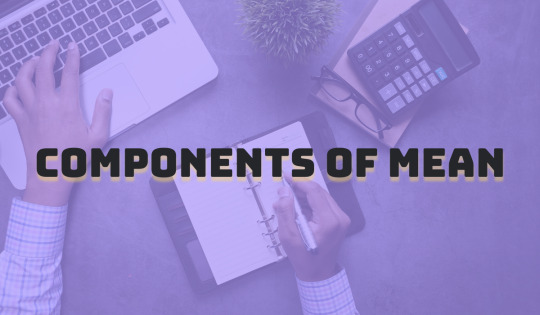
Components of the MEAN stack are divided into three categories: frontend, backend, and database.
Frontend
It refers to the front side or the client side of the application. It refers to anything that a user can engage, or interact with on the screen. The purpose of the front end is to create a smooth user interface, user experience, and straightforward internal structure which includes the design, format, and navigation of websites or web apps.
It uses HTML, CSS, and JavaScript languages to design the front portion of the web that includes components like design, theme, styles, functionality, etc. In the MEAN, the AngularJS framework is used.
AngularJS
AngularJS is the open-source JavaScript framework that is used to build single-phase applications and line-of-business applications. It changes static HTML to dynamic HTML and enhances its ability by inserting attributes and elements. It also provides the ability to create custom attributes using JavaScript. It has features like dynamic binding and dependency injection which eliminates the need to write code that was otherwise required to be written.
Backend
It is responsible for storing and organizing data and ensuring the smooth running of operations. If the frontend is the code that runs in the user’s browser, the backend code runs on the server. It receives requests from clients and has the logical knowledge to send appropriate data back to the user. It also includes a built-in database that stores all the information
The APIs built by backend developers can be used by frontend developers for integration of the client-side and server side. Backend can be built using many languages like PHP, Python,, or Java. MEAN stack uses Express and Node.js for the backend.
Express
ExpressJS or Express is a node js web application framework that provides various features for building web and mobile applications. It is used in single-page, multipage and hybrid web application development. Companies using Express are Netflix, uber, eBay, etc.
Node.js
It is an open source cross-platform runtime environment and library used for running web applications. It is used for server-side programming and primarily installed for non-blocking, event-driven servers, such as traditional websites and backend API services.
Node.js is a runtime environment meaning, it contains Web APIs that a developer can access to build a code and a JavaScript engine that parses that code. This makes it lightweight, flexible, and easy to install resulting in optimization and enhanced speed of the project.
Database
Oracle defines a database as “an organized collection of structured information, or data typically stored electronically in a computer system”. It is controlled by Database Management System (DBMS). Data is typically modeled in rows and columns in a tabular format to make processing and data querying efficient.
There are many types of databases depending upon the need of the organization. Some of the popular categories are- Relational databases, Object-oriented databases, Distributed databases, Open source databases, and Cloud databases to name a few. MEAN uses the NoSQL database program MongoDB.
MongoDB
It is a cross platform, document oriented database that provides high performance, high availability, and easy scalability. It works on the concept of collection and document. Every document in MongoDB is described in BSON, a binary representation of the data. This information can be retrienved in JSON format by applications.
It is a document database, which makes it easy for developers to store structured and unstructured data. It was built on a scale-out architecture that is very popular among all kinds of developers for developing scalable applications with evolving data schemas.
It is best if you want to: enable collaboration of large number of teams, scales to high level of rean and write traffic, scale data repository to massive size, evolve the type of deployment as the business changes, store, manage and search data with text, geospatial or time-series dimensions.
Why MEAN stack is ideal for Web and Mobile Application Development?
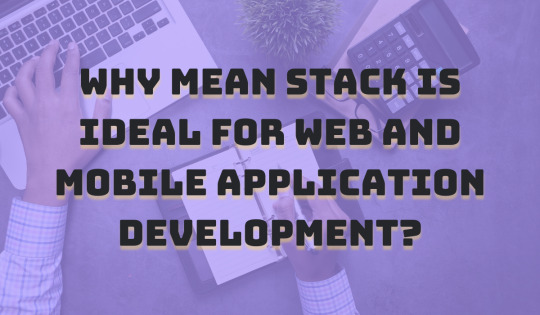
As the MEAN stack is based on JavaScript, implementation is easy. Developers can use JS platform to implement MEAN stack application for streamlined app development using a single language across the whole application.
It is a great support for organization as it is simpler for companies to follow a modern approach by using MEAN. It helps developers in expanding their skillsets to write modern apps.
It enables UI development which offers a user-friendly experience. It support MVC architecture to generate native-type web applications. Node.js is used for non-blocking type I/O and it removes the overload of the request proceeding to improve site speed. Angular is applied to improve code reusability. MEAN support open source frameworks using cloud repositories. mongoDB is also used to deal with cloud usage.
Conclusion
MEAN stack is highly flexible and modern technology that is very popular among developers. All the components are open source in nature, allowing a free of charge and generous opportunity for the developers. Whether you are building a high-throughput API, simple web application or a microservice, MEAN is the optimal choice.
0 notes
Text
5 DevOps Tools You Must Use In 2023

As businesses continue to shift towards a DevOps approach, there are several tools that can help streamline the development and deployment process. Here are five DevOps tools that you should consider using in 2023:
Kubernetes - Kubernetes is an open-source container orchestration tool that automates the deployment, scaling, and management of containerized applications. It is highly scalable and can be used across multiple cloud providers.
Jenkins - Jenkins is a popular open-source automation server that is used to automate various parts of the software development process. It can be used for building, testing, and deploying applications.
Terraform - Terraform is an infrastructure as code (IaC) tool that allows you to define and manage your infrastructure in a declarative manner. It supports multiple cloud providers and can be used to provision and manage resources such as virtual machines, containers, and networking.
Git - Git is a version control system that allows developers to collaborate on code and keep track of changes over time. It is essential for DevOps teams that are working on large codebases and need to keep track of multiple versions.
ELK Stack - The ELK Stack is a collection of open-source tools (Elasticsearch, Logstash, and Kibana) that are used to collect, parse, and analyze log data. It can be used to monitor application performance and troubleshoot issues.
If you need help implementing these tools, CloudZenix can provide expert guidance and support to ensure that your DevOps processes are running smoothly. https://cloudzenix.com/devops/devops-solutions-services/
0 notes
Text
How To Scrape TikTok Indonesia Food Recipe Data For Using Data Extraction, Exploration And Data Visualization?

We have seen similar dishes which people try and post on social media. It began with dalgona coffee in March-April 2020 with Korean garlic cheese bun. We have seen people sharing different recipes on TikTok, having demo recipe videos.
If you want to explore TikTok posts using some hashtags, which people use for exploring recipes at home. Our objective is very simple :
Extract a few top TikTok posts using the hashtags
Scrape captions, views, and likes to check for all interesting trends —playing with the data.
Collecting TikTok Data
Here, we have used an API from Food Data Scrape. The complete code of TikTok scraping code can be found here.
1. Collect Data from Food Data Scrape Endpoints
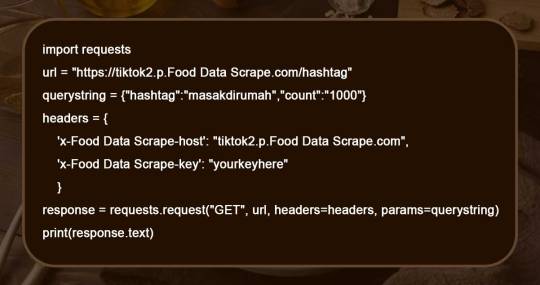
2. Parsing response data

3. Scrape hashtags and mentions from captions
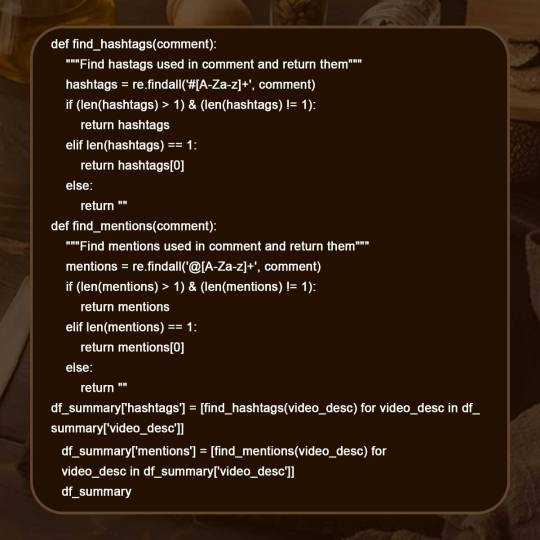

And that’s it! You have some datasets to play with!
Data Backbiting Time!
Data Backbiting Time!
Timeseries trends of posts
Plays, shares, and likes distribution across different accounts
Content of common recipes
Beginning from a few time-series analysis, a trend is here of posts over time. Just look at the timeseries charts given below to get a few insights:
Video posts are in uptrends since March 2020, topping in May 2020 (Indonesia Ramadhan season). In the last 2 months, total videos getting posted are stable of ~10 posts per day.
The length of posted videos also has an uptrend. This was ~40 seconds during April 2020 and reached ~60 seconds during August 2020.

The largest challenge here is to scrape dish names from given posts’ captions because in the TikTok posts you can just type anything without any organized fields. Similarly, the videos could be edited to exhibit the dish names rather than using captions. Here, we used many data cleansing procedures like removing special characters and numbers, filtering word noise (common words and stop words on posts), and scraping dish names from well-known trigrams and bigrams in a dataset.
A few word clouds of food are in bigrams, trigrams, and unigram. You might need to translate that as it’s within Bahasa Indonesia, however the components are mostly associated to snacks and desserts— oreo, martabak, cake, chocolate, milo, cheese stick, pie, pudding, etc. It’s easily understandable that the peak hours of the posts are during the afternoon as all these are ideal afternoon snacks!

There are different recipes about the dishes here and some posts referring the similar dishes. Summarizing rapidly, here are all viral food recipes of TikTok Indonesia:
Desserts : dessert box, brownies, cake, milk pie, smoothies bowl
Snacks : potato hotdog, rolled egg, fried tofu, coffee bread, mochi
Savory dishes : Korean fried rice, meatballs, chicken katsu, grilled chicken,

Conclusion
This concludes our discovery for important food recipes from TikTok Indonesia. Though there are boundless possibilities to extract data online, we still have to be aware of the proper stands about it. Just remember that you extract data from food recipe from only publicly accessible data and not in the destructive manner of the server accounts.
For more information about TikTok Indonesia data scraping, contact Food Data Scrape!
know more : https://www.fooddatascrape.com/how-to-scrape-tiktok-indonesia-food-recipe-data-for-using-data-extraction-exploration-and-data-visualization.php
#Scrape TikTok Indonesia Food#Data Extraction services#Data Visualization services#Data Exploration services#API from Food Data Scrape
0 notes
Text
5 justifications for why Java is as yet the best programming language
Here's the reason Java is as yet the most famous programming language for everything from versatile improvement to big business and server-side applications that engage the center level.
Java is not difficult to learn Each programming language accompanies an expectation to learn and adapt, yet Java imparts numerous likenesses to C, C++, and JavaScript. Anybody with experience in any of those dialects will get Java grammar rapidly.
Java likewise has an exceptionally inflexible and unsurprising arrangement of decisions that oversee code structure. This differentiation is distinct from other, untyped prearranging dialects where it seems like anything goes. At the point when you attempt to dominate another programming language, a reasonable arrangement of reliably upheld rules makes learning more straightforward.
Java Classes in Ahmednagar
Besides, when things don't seem OK, developers new to Java can find serious areas of strength for an organization of YouTube recordings, sites like Stack Overflow, and online discussions like Code Ranch to track down replies to a large number of inquiries.
The rich arrangement of Java APIs The Java Programming interface is broad. The standard JDK accompanies more than 200 inherent bundles containing Java APIs that take into account all that from parsing XML to interpreting between time regions. At the point when designers add on the Jakarta EE APIs, they have a significantly greater library of APIs that take into account the improvement of intricate, center-level applications and cloud-local microservices.
In any case, the rich environment of Java APIs reaches a long way past those endorsed by Prophet or provisioned through Jakarta.
For information industriousness, there's the JBoss Rest project. For cloud-local microservices improvement in Java, there's the full set-up of Spring Boot APIs. Furthermore, there's a large number of open-source Apache Programming interface projects that address an extensive variety of programming improvement use cases, from conglomerating mistake messages with log4j to tackling muddled issues with HashMaps and safeguarding Iterators through the Apache House Assortments Programming interface.
Java Training in Ahmednagar
The rich arrangement of Java APIs accessible to engineers help in the improvement of solid, mistake-free applications.
Java's apparatus environment The application advancement scene is loaded up with programming improvement apparatuses written in Java - - by Java engineers - - that are intended to rearrange and smooth out the turn of events, arrangement, and in any event, decommissioning of Java applications. A couple of instances of devices written in Java include:
Gradle: an inconceivably strong, open source fabricate the device Expert: an open source instrument intended to take care of reliance the board issues Jenkins: a Java-based ceaseless reconciliation and conveyance instrument This is in no way, shape, or form a comprehensive rundown of Java's device environment. Different instances of devices and advancements written in Java incorporate application servers like Tomcat to Red Cap's well-known, Kubernetes-local Java stack named Quarks.
Scarcely any other programming dialects partake in a similar degree of tooling support that Java does, which helps concrete itself as the best programming language.
First request Android Backing Android is the world's most famous cell phone operating system and Java is the true programming language for Android application advancement.
While Android's rendition of Java isn't the very same as what you'd find on the JDK, Google replicated more than 11,500 lines of code from the Java Standard Release when they constructed their Java clone. Accordingly, engineers can expect that the rendition of Java they see on Android is very near the first.
Assuming that you know can compose Java code for work area or server-side applications, you'll get Android advancement rapidly. The low-level contrasts between the JVM and the Dalvik Android Runtime will be generally enjoyably disconnected away from you after a concise expectation to learn and adapt. At the point when engineers learn Java, the whole Android biological system will be available to them.
Forward advancement with in reverse similarity Java advances gradually, however, it develops. With north of 25 years of development, Java has a lot of transformative upgrades to be glad about.
From the impenetrable measured quality framework that was conveyed as a feature of Venture Jigsaw, to the as-of-late added capacity of useful programming in Java with lambda capabilities, Java keeps on carrying out enormous changes that the local area requests.
Gradual augmentations in non-LTS discharges, for example, the expansion of the new Record information type and trash specialists for further developed memory of the executives, feature that the JDK is likewise continually advancing.
In any case, in the undertaking programming improvement world, the reverse similarity is similarly basically as significant as adding new highlights. Java has consistently focused on this for the stewards of the language. Seldom does a far-reaching update or component expansion make issues with code composed against more seasoned discharges.
I for one accumulated and bundled some convoluted code that was composed a long time back, and it ran with next to no issues on the most recent Java 17 delivery. At the point when venture clients realize that things won't break when they play out a JVM overhaul, it gives simply one more motivation behind why they decide to stay with Java as the best programming language.
Java Course in Ahmednagar
0 notes
Link

1 note
·
View note